Kim Parker contributed to this chapter.
The COVID-19 pandemic sent shockwaves through the U.S. labor market. Businesses shuttered, millions of Americans lost their jobs, and for many others their home became their workplace.
We tracked these changes starting from the early months of the coronavirus outbreak. Our trends outline the journey workers have been through. And new data helps show where things stand now and the lasting impact the pandemic has had on the American workplace.
Labor market impact
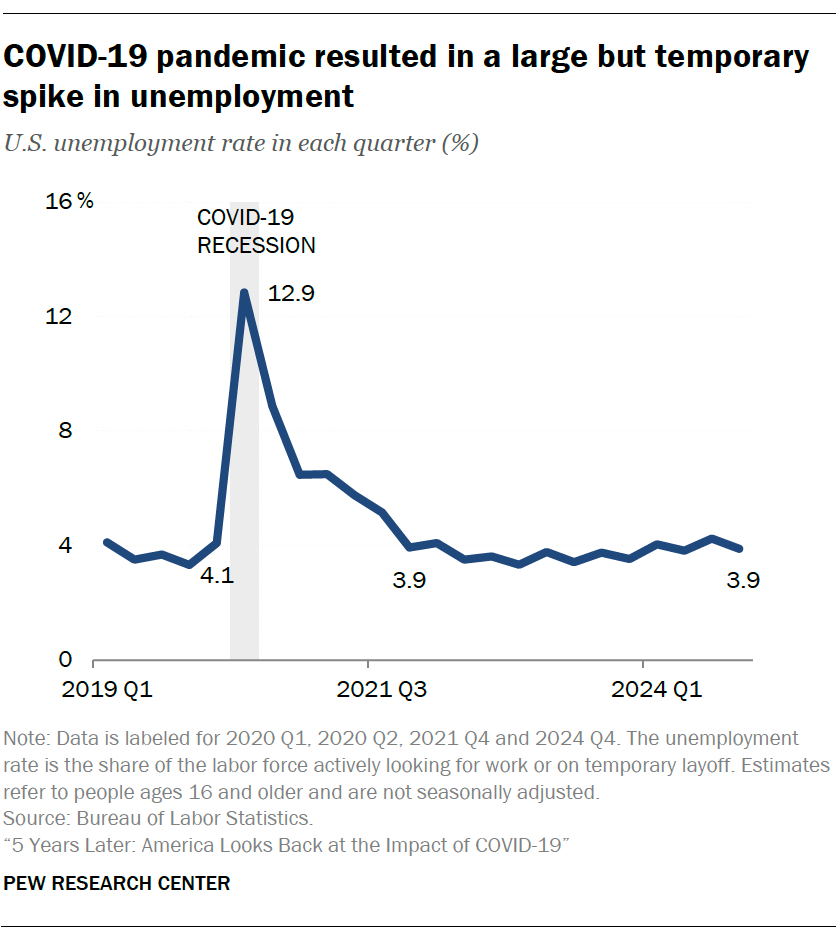
The coronavirus outbreak had an immediate impact on employment in the U.S. In February 2020, before widespread lockdowns and stay-at-home orders took hold, the national unemployment rate stood at 3.8%. By April 2020 it reached 14.4%.
The spike was intense but relatively short-lived. By the fourth quarter of 2021, the unemployment rate was back around 4%.
Some groups were hit harder than others by the early job losses:
- Women
- Immigrants
- Young workers (ages 16 to 24)
- Workers who hadn’t completed high school
- Lower-income workers
In addition, millions of workers withdrew from the labor force altogether. More women than men dropped out of the labor force during the first year of the pandemic.
How workers experienced the pandemic from start to finish
Our surveys traced the arc of experiences for American workers from the outset of the pandemic to what work life looks like now. In the sections below, we walk through the key takeaways from our last five years of polling on this topic.1
Jump to read about: The pandemic’s initial impact on workers | What things look like today | Looking back: The challenges working parents faced | What happened when workplaces began to reopen
The pandemic’s initial impact on workers
Not all workers had the option of working from home
As the pandemic took hold, many workers were able to shift their duties from their office or workplace to home. But it’s important to keep in mind that a majority of workers (roughly 60%) do not have jobs that can be done from home. Many of these workers lost their jobs in the early months of the pandemic, as businesses and retail establishments temporarily shut down. Others had to continue to show up for work, even as they were at risk of contracting the coronavirus.
Some demographic groups were more likely than others to not have jobs that can be done from home, a 2020 survey found:
- Men were more likely than women (64% vs. 58% said their job cannot be done from home).
- Workers without a four-year college degree were much more likely than those with a bachelor’s degree or more education (77% vs. 37%).
- Lower-income workers were more likely than middle- and upper-income workers (76% vs. 63% and 44%, respectively).
In the fall of 2020, we asked workers with jobs that could not be done from home how concerned they were about being exposed to the coronavirus from people they interacted with at work; 53% said they were very or somewhat concerned about this. About four-in-ten (39%) said they were very satisfied with the measures their employer had put in place to protect them from being exposed.
The swift transition to working from home
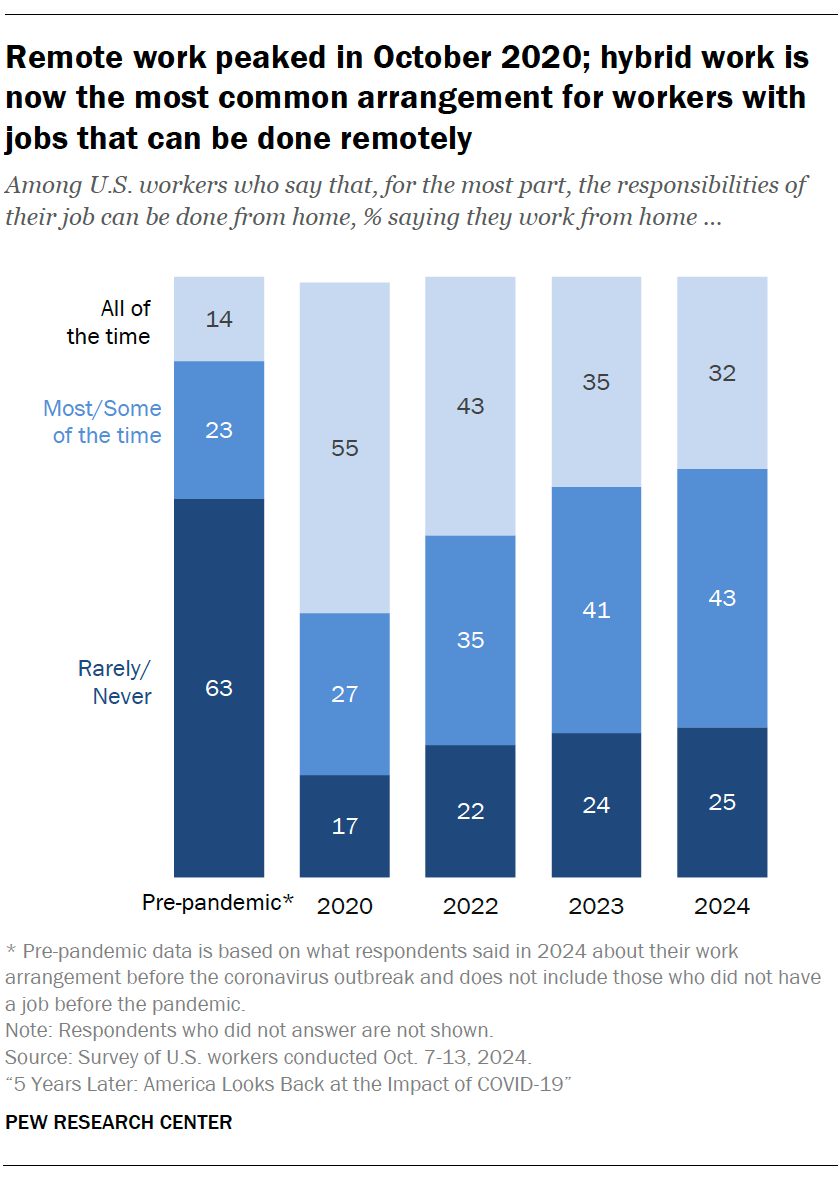
Looking back, only 14% of workers whose jobs currently can, for the most part, be done from home – “teleworkable” jobs – say they worked from home all the time before the coronavirus outbreak. By October 2020, 55% of those with teleworkable jobs were doing so, according to a survey at that time.
That share has since come down. As of October 2024, about a third (32%) say they are working from home all the time.
Notably, the share working from home most or some of the time increased since the start of the pandemic as offices gradually began to reopen. Now, 43% of workers say they have this type of hybrid schedule, up from about a third in 2022.
How did workers respond to the shift to telework?
Our October 2020 survey found that most employed adults who were working from home said the transition had been relatively easy.
- Large majorities said it had been easy for them to have the technology they need, to meet deadlines and to have an adequate workspace.
- However, about three-in-ten or more said it had been difficult to be able to get their work done without interruptions and to feel motivated to work.
- Younger workers were especially likely to point to difficulty feeling motivated and being able to work without interruptions.
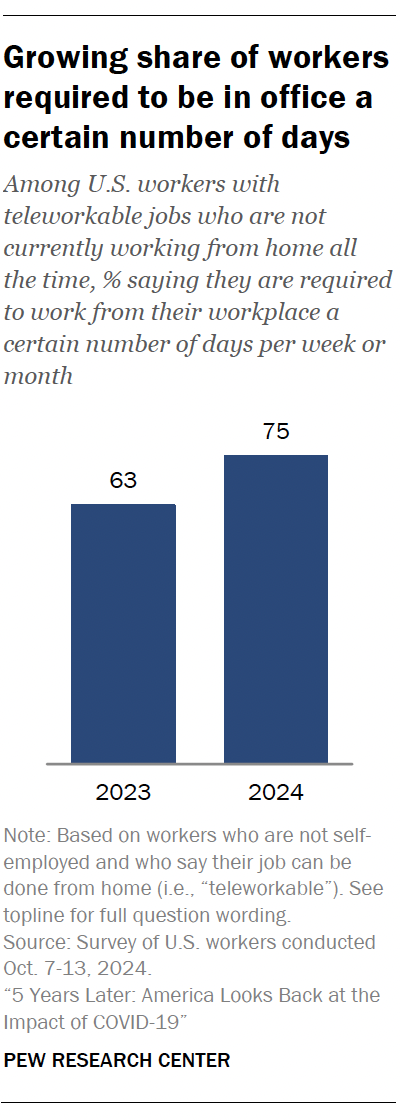
What things look like today
As we approach the five-year mark of the start of the pandemic, a growing share of hybrid workers are facing mandates from their employers to return to the office.
Among those with teleworkable jobs who say they’re not currently working from home all the time, 75% say their employer now requires them to work from their office, workplace or job site a certain number of days per week or month. That share is up significantly from 63% in 2023.
Advantages and disadvantages of working from home
In our polling throughout the past five years – including in our most recent survey – workers have identified a couple of clear upsides to working from home.2
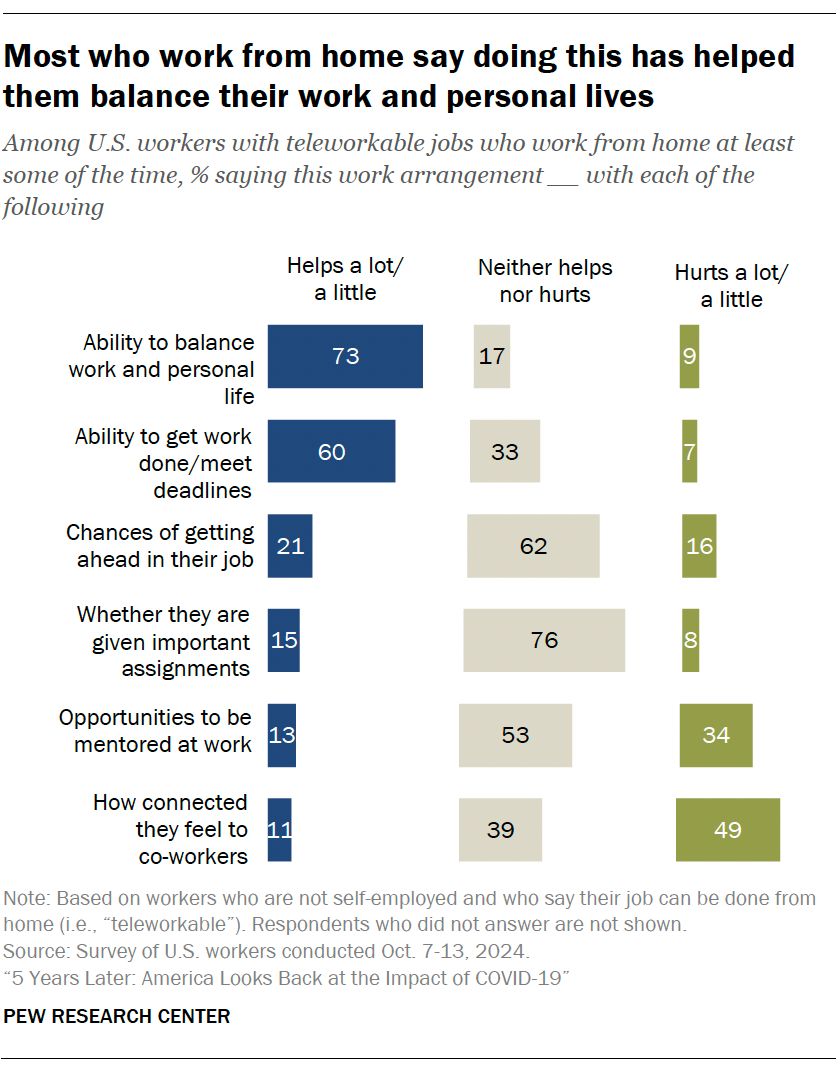
- Work-life balance: Among workers with a teleworkable job who say they work from home at least sometimes, 73% now say their current arrangement has helped them when it comes to balancing work and their personal life. Only 9% say it’s hurt, and 17% say it has neither helped nor hurt.
- Productivity: 60% say their current work arrangement has helped their ability to get work done and meet deadlines. Only 7% say it’s hurt their ability to do this, and 33% say it’s neither helped nor hurt.
And there are couple of downsides.
- Feeling disconnected from co-workers: 49% of those who are working from home at least sometimes say their current work arrangement has made it harder for them to feel connected with their co-workers; 11% say it’s helped them feel connected. A sizable share (39%) say it has neither helped nor hurt.
- Fewer opportunities for mentorship: 34% say their current work arrangement has hurt their opportunities for mentorship at work. Only 13% say it’s helped. Some 53% say it’s neither helped nor hurt.
Most workers who are working from home at least sometimes say their current work arrangement has neither helped nor hurt these aspects of work:
- Their chances of getting ahead in their job
- Whether they’re given important assignments
What if your employer said you couldn’t work from home?
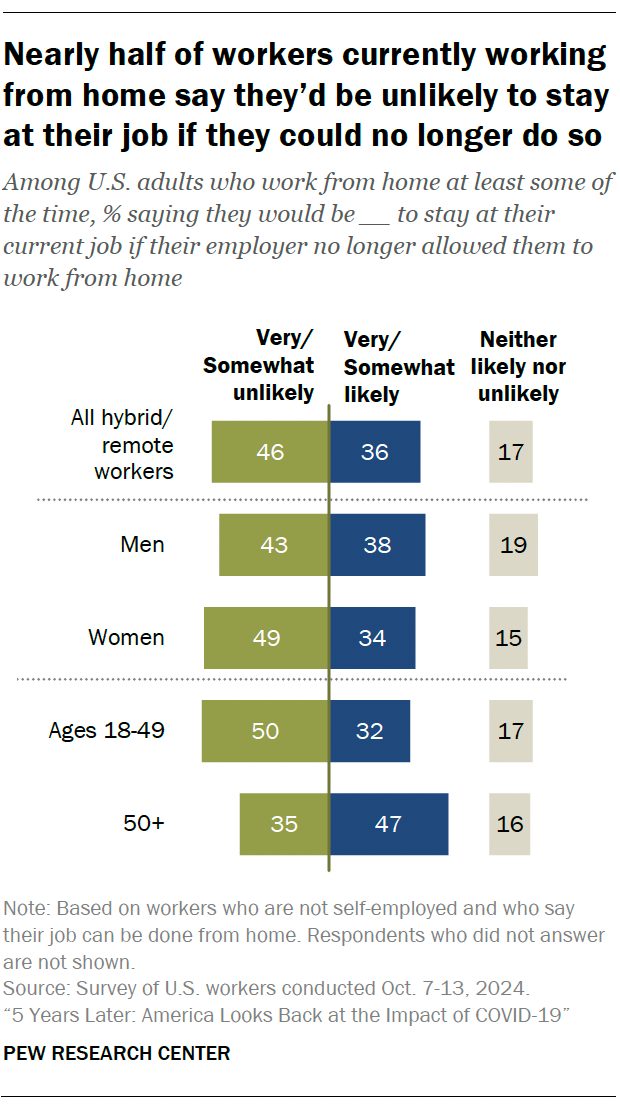
So how attached are workers to their new, hybrid work setup? We asked workers who currently work from home at least some of the time how they would feel if their employer no longer allowed them to do this.
Almost half (46%) say they would be unlikely to stay at their current job if this happened, including 26% who say they’d be very unlikely to stay. A smaller share (36%) say they’d be likely to stay at their job.
Women are somewhat more inclined than men to say they’d be unlikely to stay at their job if they could no longer work from home (49% vs. 43%). And younger workers (ages 18 to 49) are more likely than those 50 and older to say this (50% vs. 35%).
Are video meetings a good substitute for in-person contact?
The pandemic ushered in a new era for video calling and online conferencing. In October 2024, we asked workers with teleworkable jobs how often they use services like Zoom or Webex as part of their work. More than half (54%) say they use these services often, and an additional 25% say they use them sometimes. About one-in-five (21%) say they hardly ever or never use these services. These shares are largely unchanged from 2022.
There are big differences by education and income. Among those with a teleworkable job, 86% who have a bachelor’s degree or more education say they use these services at least sometimes. This compares with 69% of those with some college or less education. Similarly, 92% of upper-income workers use these services regularly, compared with 76% of middle-income and 62% of lower-income workers.
Most workers who use these services at least sometimes (74%) say they’re a good substitute for in-person contact. A quarter say they are not a good substitute.
What if there was another pandemic?
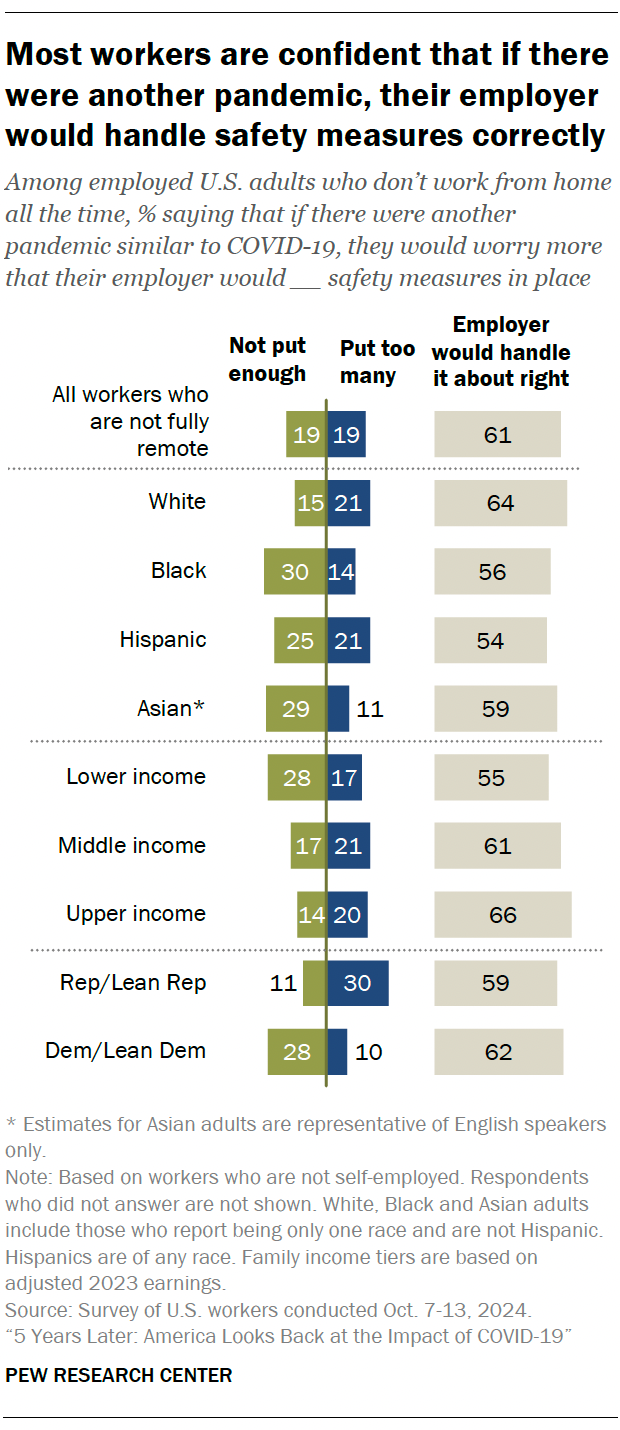
Our October 2024 survey also asked workers who are not self-employed how they would feel about the safety of their workplace if there were another pandemic similar to the COVID-19 pandemic.
Among those who don’t work from home all the time, 61% think their employer would handle safety measures at their workplace about right. Roughly one-in-five (19%) say they worry their employer would not put enough safety measures in place, and the same share say they’d be concerned that their employer would put too many measures in place.
Some groups of workers are more likely than others to say they worry their employer wouldn’t put enough safety measures in place:
- Black, Hispanic and Asian workers
- Lower-income workers
- Democrats and Democratic leaners
Looking back: The challenges working parents faced
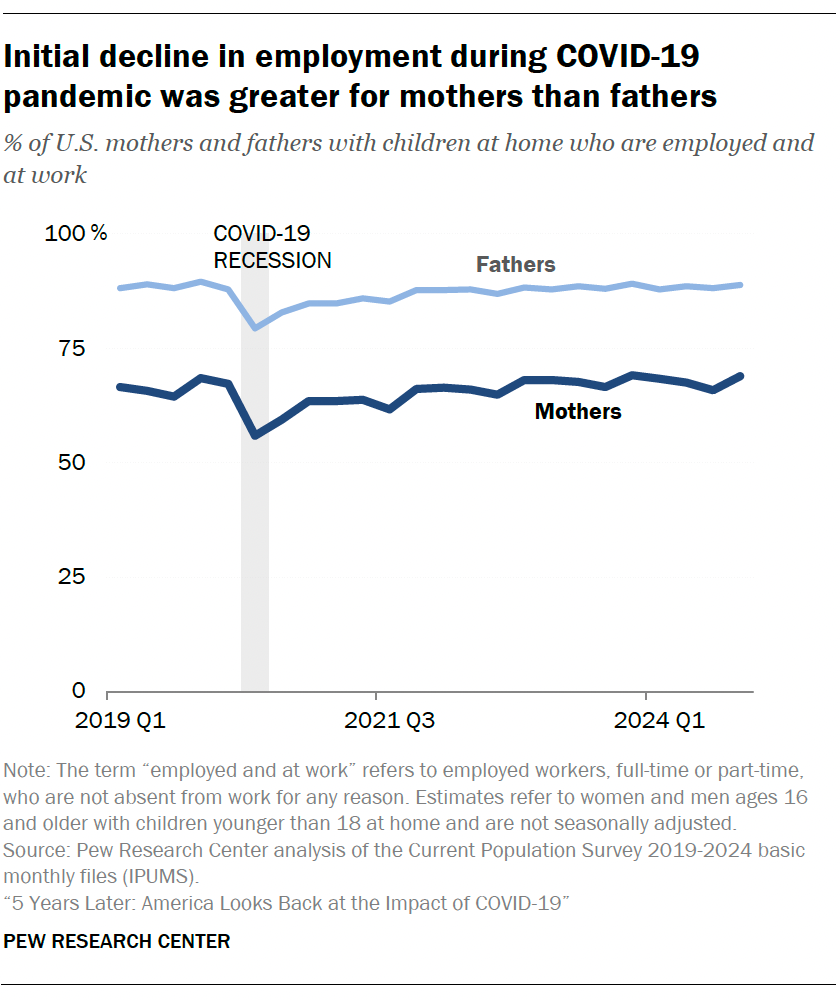
The pandemic presented a special set of challenges for parents. Schools and day care centers shut down for extended periods of time, and many parents had to juggle child care and online schooling with their regular work schedules.
There was a sharp dip in the share of parents – especially mothers – in the labor force during the second quarter of 2020. Employment among moms didn’t fully rebound until the last quarter of 2022.
There was also a decline in the number of hours mothers and fathers were working during the early months of the pandemic. That rebounded more quickly. Here are a few notable findings on what working parents faced during the pandemic.
- Full-time vs. part-time work: Our surveys found a drop in the share of mothers saying that at this point in their life, working full time would be best for them personally (from 51% in the summer of 2019 to 44% in October 2020). Fathers’ views on this didn’t change.
- Handling child care: During the first year of the pandemic, a rising share of working parents with children younger than 12 told us child care had been difficult for them to handle. In March 2020, 38% said this, and by October 202o, the share had risen to 52%. We saw this trend among both working mothers and working fathers.
- Caring for kids while working: In October 2020, we also asked parents how much child care they were doing while working. Among parents who were working from home all or most of the time, 36% of moms and 16% of dads said they had a lot of child care responsibilities when working from home. Not surprisingly, these were many of the same parents who said balancing work and family responsibilities had gotten harder during the pandemic.
What happened when workplaces began to reopen?
In 2022, we saw an important shift in the reasons people were working from home. As workplaces began to reopen, fewer workers told us they were working from home all or most of the time (compared with late 2020). But among those who were still working from home, a majority said they were doing this because they wanted to – not because their workplace was closed or unavailable.
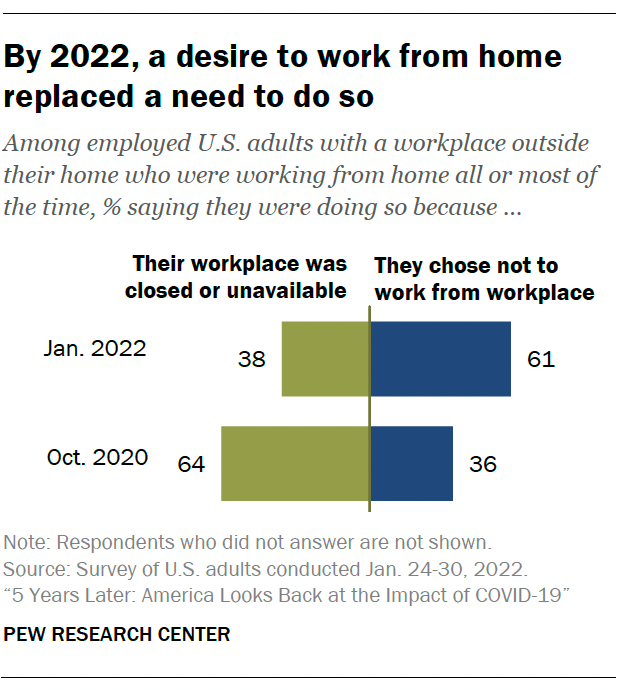
We also asked workers who had the option of working from home but were choosing to go into the office instead why they didn’t want to work from home more often. Most said it was just their preference or that they felt more productive in the office. Relatively few said they felt pressure to be at their workplace or that they thought they’d have more opportunities for advancement if they showed up at the office.
Concerns over safety in the workplace
Even as life had started to get back to normal, many workers were still concerned about being exposed to the coronavirus at their workplace. In January 2022, about half of all workers who told us they interacted in person with others at work at least sometimes said they were either very (20%) or somewhat (32%) concerned about being exposed. This was virtually unchanged from October 2020.
Some groups were more concerned about this than others:
- Black and Hispanic workers
- Younger workers
- Lower-income workers
Most workers who were not working exclusively from home remained at least somewhat satisfied with the measures their employer had put in place to protect them from being exposed. Black and Hispanic workers were among the least likely to say they were very satisfied.
What about vaccines?
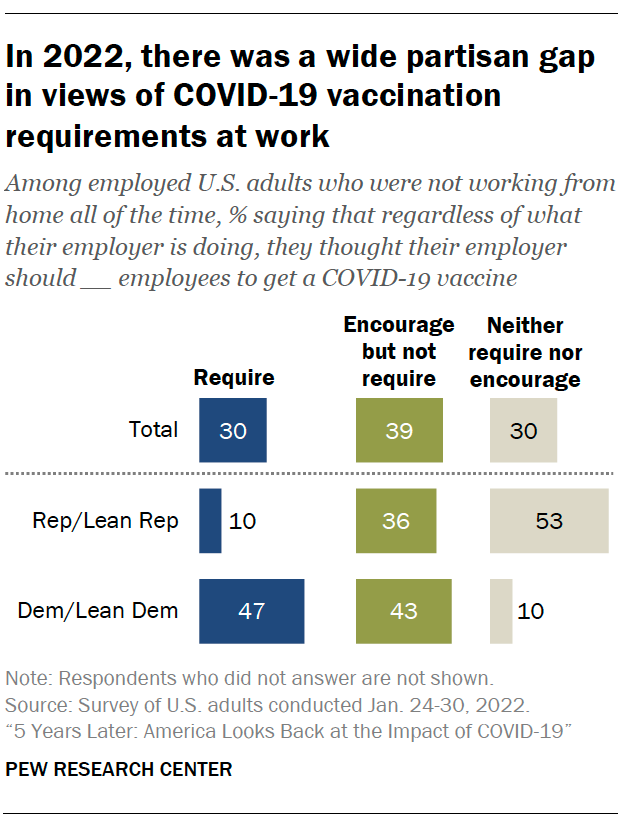
Our 2022 survey found that among adults who weren’t working from home all the time, 22% said their employer had required them to get a COVID-19 vaccine. An additional 47% said their employer had encouraged this but not required it, and 30% said their employer had done neither.
Most workers weren’t in favor of vaccine requirements from their employers. Only 30% said their employer should require vaccines.
There was a big party divide here – 47% of Democrats and independents who lean Democratic thought their employer should require vaccines. This compared with only 10% of Republicans and Republican leaners.




